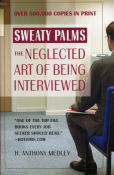| What REALLY goes on in a job interview? Find out in the new revision of "Sweaty Palms: The Neglected Art of Being Interviewed" (Warner Books) by Tony Medley, updated for the world of the Internet . Over 500,000 copies in print and the only book on the job interview written by an experienced interviewer, one who has conducted thousands of interviews. This is the truth, not the ivory tower speculations of those who write but have no actual experience. "One of the top five books every job seeker should read," says Hotjobs.com. | |
| Changeling (10/10) by Tony Medley Run time 140 minutes. When it comes to lawlessness and political corruption, Los Angeles in the 1920s and 1930s was worse than Tombstone under the Earp brothers in 1882, or any other frontier town. Police Chief James E. Davis (Colm Feore) was as evil a public servant that has appeared since the Revolution, ignoring the law and creating his own Gestapo out of the LAPD. This film shows the first person to successfully stand up to him, although it took another ten years to actually get rid of him once and for all, a story that should be good enough for another movie. Christine Collins (Oscar® winner Angelina Jolie), a phone company supervisor, took on the entire Los Angeles establishment to find her son, Walter (Gattlin Griffith), who disappeared suddenly and without a trace while she was at work one day. Director Clint Eastwood takes a big chance when he starts this movie with the stark statement, “This is a true story.” Undoubtedly he wanted to salute Christine's courage. But, even though it is mostly true, there are stretches in which screenwriter J. Michael Stracynski has included composite characters, like Detective Lester Ybarra (Michael Kelly), who, in the film, basically breaks the case, and inventing a back story for Davis. Stracynski single-handedly rescued Christine’s heroic struggle when someone at City Hall called him when he was a reporter for the Los Angeles Times and alerted him that the City was burning old records and there was at least one that he should see. They were the transcripts from the hearings involving Collins and the LAPD before the City Council. Stracynski immediately recognized a great story and, also, wanted to pay homage to a courageous woman. He read all the transcripts and wrote this screenplay. Jolie gives an emotional performance portraying a woman who loses her son with heartbreaking poignancy, crying real tears throughout the film. The corrupt LAPD, under Chief Davis, found a boy (Devon Conti) in the Midwest, and claimed he was Walter. When she met him, Christine immediately knew he wasn’t Walter, and that started the downward spiral for Christine. The LAPD wanted her to acknowledge that this boy was Walter so they could reap the favorable publicity, but she fought them tooth and nail. Her main antagonist is LAPD Captain J.J. Jones (Jeffrey Donovan), who moves heaven and earth to shut Christine up. Donovan gives a wonderful performance as the hateful, unsympathetic Jones. There are fine performances by a high-quality cast. John Malkovich as Christine’s one champion, Reverend Gustav Briegleb, Amy Ryan as a Prostitute who befriends her, Jason Butler Harner as the notorious Gordon Northcott, Denis O’Hara as a psychiatrist in charge of the psycho ward, and Geoff Pierson as the legendary attorney S.S. Hahn, who was the primogenitor of a famous Los Angeles political family that included longtime City Councilman Kenny Hahn (who was instrumental in bringing the Dodgers from Brooklyn to Los Angeles) and his son who became Mayor, James Hahn. Eastwood tells the story straight, as it actually happened, eschewing a Hollywood ending, although he fails to inform the audience about what happened to Christine, Davis and Jones. I know what happened to Christine and Davis, but won’t tell because that knowledge might be a spoiler. I don’t know what happened to Jones. I think after sitting through this enthralling but difficult movie, and after having been told specifically that this is a true story, not something "based on" a story or a person, the audience is entitled to know what happened to all three. As good a thriller as this is, and as true as it is, the star of the movie for me was the loving recreation of 1928 Los Angeles. Production designer James Murakami and location manager Patrick Mignano did award-deserving work recreating pre-prohibition Los Angeles. Visual effects supervisor Michael Owens added effects enhancements and re-created backdrops, such as the city skyline and the red streetcars that then populated the region. Their work was so effective that when the closing credits were shown over a shot of downtown Los Angeles with the red cars running my guest leaned over to me and asked if I thought they were using archival films. It’s worth staying for the closing credits just to watch the activity on the 1928 downtown street over which the credits are shown. October 23, 2008
|
|
|
|
|
